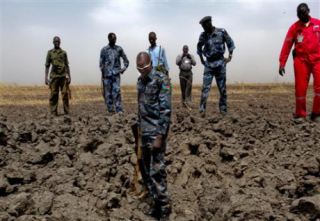S. Sudanese rebels claim responsibility for borderland attack Juba attributed to Khartoum
By Toby Collins
March 28, 2012 (LONDON) – South Sudanese rebels, the South Sudan Liberation Army/Movement (SSLA/M) claim to have captured a base belonging to the South Sudan army, the Sudan People’s Liberation Army (SPLA) in Lalop, Parieng county, Unity state, at 7.00 pm local time on Tuesday.

These claims have not been independently verified.
“Our forces are now advancing to Rubkona” state the SSLA/M.
The SSLA/M told Sudan Tribune on Tuesday that claims that the SPLA is engaging with Khartoum’s Sudan Armed Forces (SAF) in the region are “propaganda coming from Juba”.
The SSLA/M claim to have “deployed five battalions right now and they are the ones engaging the SPLA. Once we capture Parieng County, we will be matching to Bentiu.”
The president of South Sudan, Salva Kiir, announced on Monday that the SPLA had been fighting SAF in border regions including oil-rich Heglig. He made no mention of rebel activity in his address.
In response to Juba’s claims SAF spokesman, al-Sawarmi Khalid Sa’ad said the border clashes were “limited” and carried out by the SPLA as well as fighters from Darfur rebels the Justice and Equality Movement (JEM).
The SSLA/M allege that also assisting the SPLA were the SPLA-North (SPLA-N); a north Sudanese rebel group fighting SAF in Blue Nile and South Kordofan states.
SPLA-N is in a coalition with JEM; a rebel group involved in the Darfur conflict, which borders South Kordofan. Together with the Sudan Liberation Movement-Abdel Wahid al-Nur and Sudan Liberation Movement-Minni Minnawi they form the Sudan Revolutionary Front.
This coincided with an earlier press release from the SSLA/M, claiming their forces had captured an SPLA military base in northern Pariang county.
In this earlier release they claimed to have “dislodged” 5,000 SPLA soldiers, as well as destroying two tanks, four mounted Toyota Land Cruisers and two Russian made military trucks.
The SSLA/M is calling for an urgent evacuation of Unity state as by 1 April the “SSLA operational commanders will take tea inside Bentiu town.”
The head of the SSLA high military command, James Gai Yoach, allegedly received declarations of allegiance from five of Unity state’s paramount chiefs on Monday, who will welcome their forces with “flowers and milk”.
An attack by combined forces SSLA and South Sudan Defence Army (SSDA) under the command of Johnson Olony on Malakal in Upper Nile state, they allege, is also imminent.
SSLA/M and SAF
It is unclear whether the SSLA/M interprets the SPLA’s engagement with SAF as an opportunity to strike its weakened adversary. And if so, what the SSLA/M envisages as a favourable outcome; SSLA/M victories against the SPLA could leave the door open for SAF encroachment.
This ambiguity is particularly pertinent in relation to a recent rebel coalition spat which saw a senior member claiming backing from Khartoum. The SSLA/M have now distanced themselves from Tong Lual Ayat, the leader of the South Sudan People Liberation Army/Movement (SSPLA/M), but with allegations that rebels in the region are in the possession of new, Chinese-made arms – as used by SAF – their allegiances remain a matter of speculation.
The SSPLA/M released a manifesto in December 2011 calling for South Sudan to once again be governed by Khartoum. When the inherent incompatibility in this agenda with the SSLA/M’s manifesto was flagged up, the SSPLA/M swiftly made a retraction.
In response to a query on this subject, the SSPLA/M spokesperson, Bapiny Montuil, told Sudan Tribune on Wednesday that, “our main goal is to deal with Kiir’s regime and then address the outstanding and pending issues between the North and the South such as Abyei, border demarcation and the rest.”
Montuil previously served as a brigadier general in SAF after refusing to join the SPLA after the Juba Declaration in 2006.
SSLA/M and the Nuer White Army (NWA)
On 19 March the SSLA/M claimed it would be offering military support to the NWA which is in conflict with the Murle ethnic group in Jonglei state.
The NWA are a militia claiming to protect Nuer interests in Jonglei in the face of Murle aggression.
Whether this coaltion is on hiatus while the SSLA/M is engaging with the SPLA in Unity is unclear.
In January the UN estimated 120,000 “may need relief assistance” due to the conflict in Jonglei since. There has been a long-running cattle-raiding/child-abduction feud between the Luo-Nuer and Murle ethnic groups which has escalated with the advent of readily available small arms. The proliferation of which is due, in part, to two decades of Sudanese civil war, which ended in 2005.
They SSLA/M on Tuesday confirmed that the NWA is acting under the leadership of Bor Doang but did not know the identity of his Murle counterpart or if their leadership structure includes such a role. The NWA has previously identified itself as a youth group which dissociates itself from the traditional leadership structures which have, historically, been used to mediate such disputes.
There has been scant information from the Murle Diaspora and the Murle in South Sudan on their perspective of the conflict, unlike the vocal Luo-Nuer who claim that the Murle have been driven to abducting their children as they are suffering from an infertility endemic; a view shared by Kiir.
According to the UN Environmental Program the Murle were in Ethiopia until the 19th century. Some remained their until the 1990s while others were driven west by local Nilotes. They established an homeland in Pibor county, Jonglei state in the 1930s, since which, environmental pressures have impinged upon their pastoralist lifestyle.
Little evidence can be found to support the infertility claim. However, the motivation to rationalise the denigration of one of South Sudan’s pariah ethnic groups, in order to legitimise the attribution of blame, is self-evident.
The notable Murle rebel leader, David Yauyau, signed a peace deal with Juba government in June 2011.
(ST)
